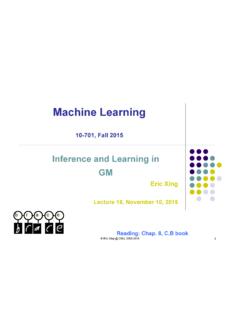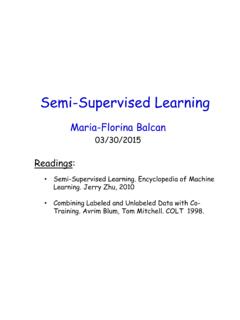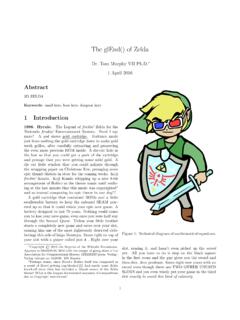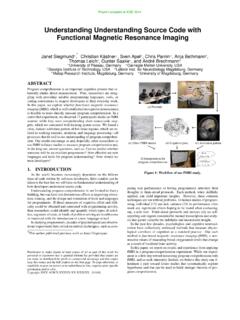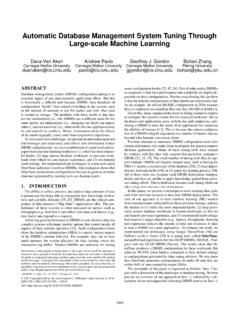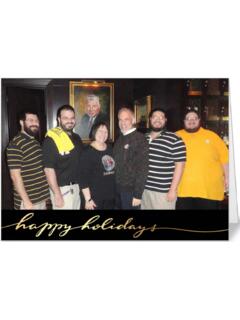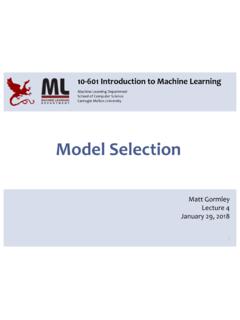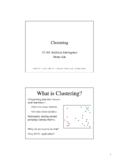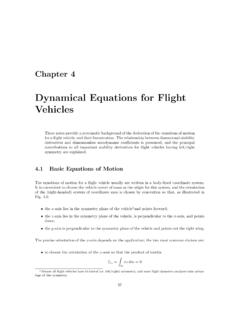Transcription of Chapter 11. Facial Expression Analysis
1 Chapter 11. Facial Expression AnalysisYing-Li Tian,1 Takeo Kanade2, and Jeffrey F. Cohn2,31 IBM T. J. Watson Research Center, Hawthorne, NY 10532, Institute, Carnegie Mellon University, Pittsburgh, PA 15213, of Psychology, University of Pittsburgh, Pittsburgh, PA 15260, Principles of Facial Expression What Is Facial Expression Analysis ? Facial expressions are the Facial changes in response to a person s internal emotional states,intentions, or social communications. Facial Expression Analysis has been an active researchtopic for behavioral scientists since the work of Darwin in 1872 [18,22,25,71]. Suwa etal. [76] presented an early attempt to automatically analyze Facial expressions by tracking themotion of 20 identified spots on an image sequence in 1978.
2 After that, much progress hasbeen made to build computer systems to help us understand and use this natural form of humancommunication [6,7,17,20,28,39,51,55,65,78,81,92,93,94 ,96].In this Chapter , Facial Expression Analysis refers to computer systems that attempt to auto-matically analyze and recognize Facial motions and Facial feature changes from visual informa-tion. Sometimes the Facial Expression Analysis has been confused with emotion Analysis in thecomputer vision domain. For emotion Analysis , higher level knowledge is required. For exam-ple, although Facial expressions can convey emotion, they can also express intention, cognitiveprocesses, physical effort, or other intra- or interpersonal meanings.
3 Interpretation is aided bycontext, body gesture, voice, individual differences, and cultural factors as well as by facialconfiguration and timing [10,67,68]. Computer Facial Expression Analysis systems need toanalyze the Facial actions regardless of context, culture, gender, and so accomplishments in the related areas such as psychological studies, human movementanalysis, face detection, face tracking, and recognition make the automatic Facial expressionanalysis possible. Automatic Facial Expression Analysis can be applied in many areas such asemotion and paralinguistic communication, clinical psychology, psychiatry, neurology, painassessment, lie detection, intelligent environments, and multimodal human computer interface(HCI).
4 Basic Structure of Facial Expression Analysis SystemsFacial Expression Analysis includes both measurement of Facial motion and recognition of ex-pression. The general approach to automatic Facial Expression Analysis (AFEA) consists of2 Ying-Li Tian, Takeo Kanade, and Jeffrey F. Cohnthree steps ( ): face acquisition, Facial data extraction and representation, and facialexpression structure of Facial Expression Analysis acquisition is a processing stage to automatically find the face region for the inputimages or sequences. It can be a detector to detect face for each frame or just detect face inthe first frame and then track the face in the remainder of the video sequence.
5 To handle largehead motion, the the head finder, head tracking, and pose estimation can be applied to a facialexpression Analysis the face is located, the next step is to extract and represent the Facial changes causedby Facial expressions. In Facial feature extraction for Expression Analysis , there are mainly twotypes of approaches: geometric feature-based methods and appearance-based methods. The ge-ometric Facial features present the shape and locations of Facial components (including mouth,eyes, brows, and nose). The Facial components or Facial feature points are extracted to forma feature vector that represents the face geometry. With appearance-based methods, image fil-ters, such as Gabor wavelets, are applied to either the whole-face or specific regions in a faceimage to extract a feature vector.
6 Depending on the different Facial feature extraction meth-ods, the effects of in-plane head rotation and different scales of the faces can be eliminated byface normalization before the feature extraction or by feature representation before the step ofexpression Expression recognition is the last stage of AFEA systems. The Facial changes canbe identified as Facial action units or prototypic emotional expressions (see ). Depending on if the temporal information is used, in this Chapter we classified therecognition approaches as frame-based or Organization of the ChapterThis Chapter introduces recent advances in Facial Expression Analysis . The first part discussesgeneral structure of AFEA systems.
7 The second part describes the problem space for facialexpression Analysis . This space includes multiple dimensions: level of description, individualdifferences in subjects, transitions among expressions, intensity of Facial Expression , deliberateversus spontaneous Expression , head orientation and scene complexity, image acquisition andresolution, reliability of ground truth, databases, and the relation to other Facial behaviors orChapter 11. Facial Expression Analysis3nonfacial behaviors. We note that most work to date has been confined to a relatively restrictedregion of this space. The last part of this Chapter is devoted to a description of more specificapproaches and the techniques used in recent advances.
8 They include the techniques for faceacquisition, Facial data extraction and representation, and Facial Expression recognition. Thechapter concludes with a discussion assessing the current status, future possibilities, and openquestions about automatic Facial Expression Facial Expression (posed images from database [43] ). 1, disgust; 2,fear; 3, joy; 4, surprise; 5, sadness; 6, anger. From Schmidt and Cohn [72], with Problem Space for Facial Expression Level of DescriptionWith few exceptions [17,20,30,81], most AFEA systems attempt to recognize a small setof prototypic emotional expressions as shown in , ( , disgust, fear, joy, surprise,sadness, anger).
9 This practice may follow from the work of Darwin [18] and more recentlyEkman and Friesen [23,24] and Izard et al. [42] who proposed that emotion-specified expres-sions have corresponding prototypic Facial expressions. In everyday life, however, such proto-typic expressions occur relatively infrequently. Instead, emotion more often is communicatedby subtle changes in one or a few discrete Facial features, such as tightening of the lips in angeror obliquely lowering the lip corners in sadness [11]. Change in isolated features, especially inthe area of the eyebrows or eyelids, is typical of paralinguistic displays; for instance, raisingthe brows signals greeting [21]. To capture such subtlety of human emotion and paralinguisticcommunication, automated recognition of fine-grained changes in Facial Expression is Facial action coding system (FACS: [25]) is a human-observer-based system designed todetect subtle changes in Facial features.
10 Viewing videotaped Facial behavior in slow motion,trained observers can manually FACS code all possible Facial displays, which are referred to asaction units and may occur individually or in consists of 44 action units. Thirty are anatomically related to contraction of a specificset of Facial muscles ( ) [22]. The anatomic basis of the remaining 14 is unspecified( ). These 14 are referred to in FACS as miscellaneous actions. Many action unitsmay be coded as symmetrical or asymmetrical. For action units that vary in intensity, a 5-point ordinal scale is used to measure the degree of muscle contraction. someexamples of combinations of FACS action Ekman and Friesen proposed that specific combinations of FACS action units rep-resent prototypic expressions of emotion, emotion-specified expressions are not part of FACS;they are coded in separate systems, such as the emotional Facial action system (EMFACS) [37].
